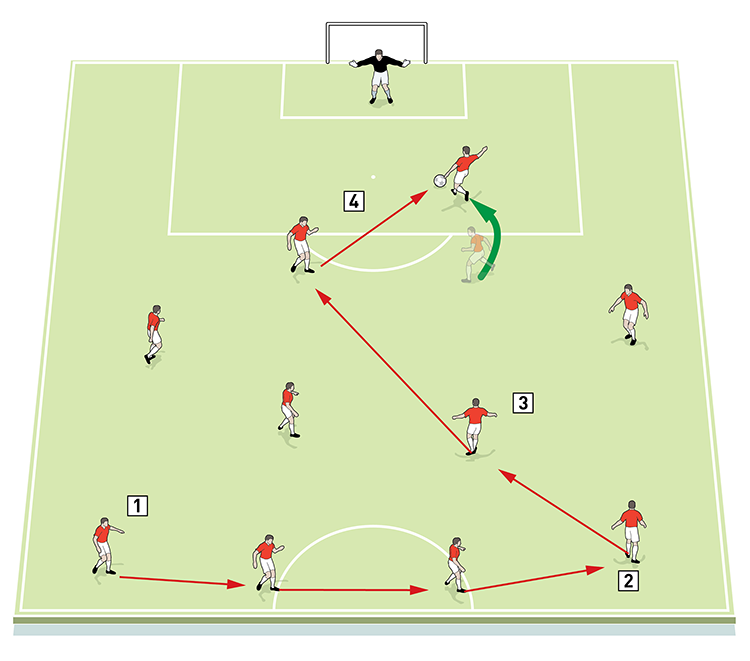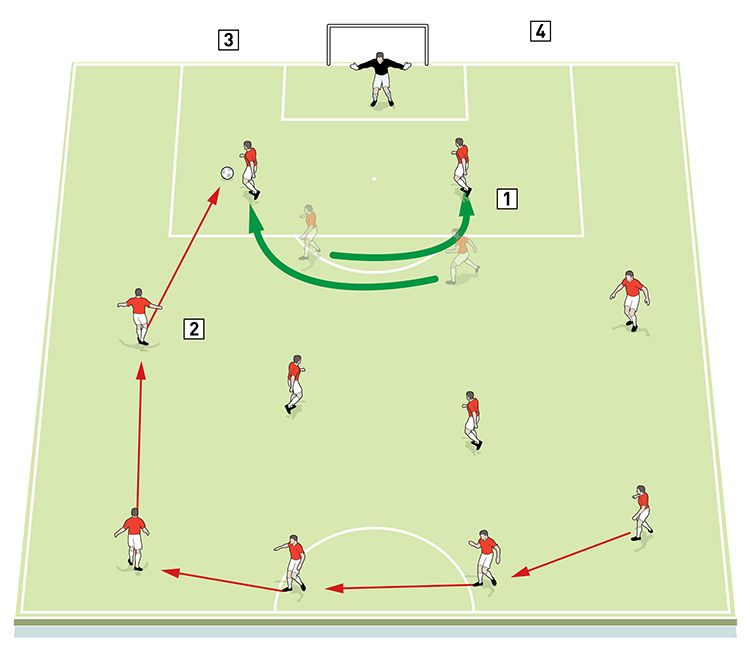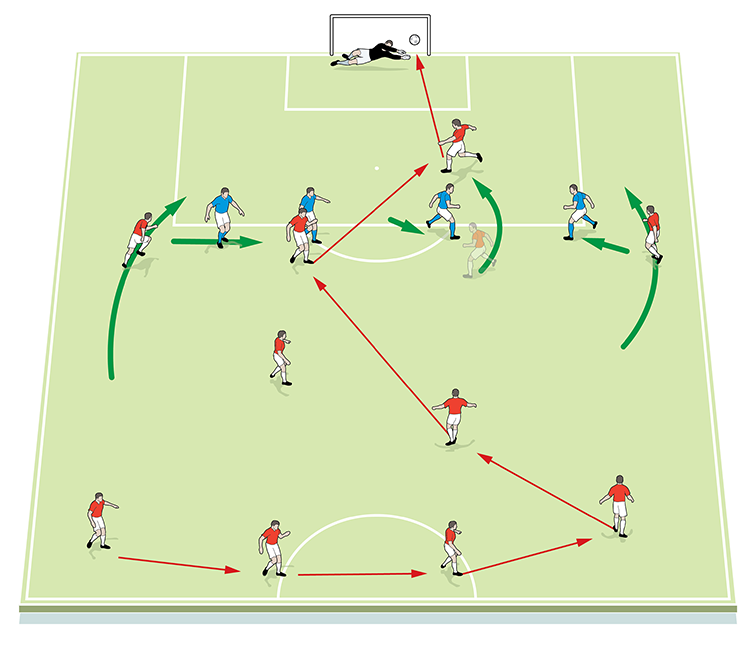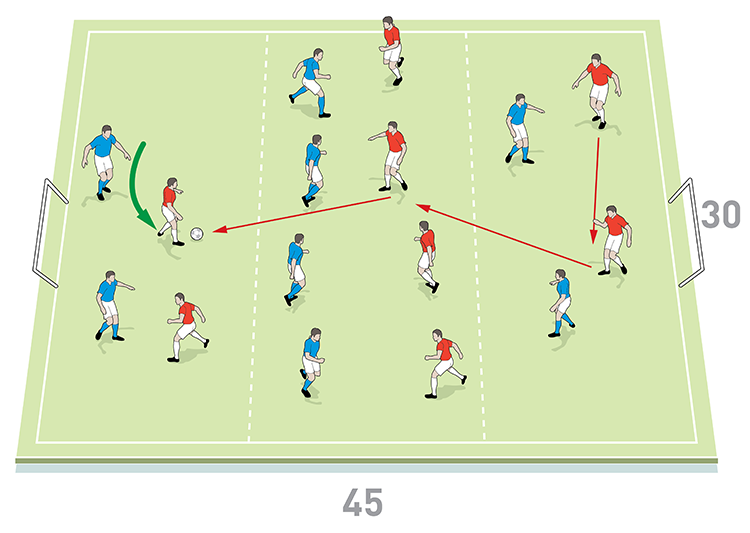You are viewing 1 of your 1 free articles
Link play between forwards
| Area | Use of half-pitch |
| Equipment | Balls, cones, goal |
| No. of Players | 8v8 plus keepers |
| Session Time | Unopposed practices 20mins, Opposed practices 20mins, Small-sided game 20mins |
Some modern-day formations can make it difficult to gain a true understanding of attacking principles. For that reason, working on movements and link play in the attacking third is key.
At Burnley we like to operate in a 4-4-2 formation, and we make sure our strikers understand the importance of linking and being productive. It’s difficult to get two players linking ‘naturally’, and young centre-forwards these days are often schooled in 4-3-3, so educating them to play with two up front is vital for real centre-forward understanding. What I will say though is that attacking play is easier to coach compared to other outfield areas for the obvious reason that a goal comes as a result... we hope!
This type of session will be used on an ad hoc basis but more so when new centre-forwards have been brought in.
What do I get the players to do?
At first we start without opposition players being involved. Passing patterns and combinations from full-backs and midfield players form the basis of the first three practices we show in this session.
1- Build-up play into two strikers
In this first phase the practice is run without opponents, as shown.

2. An initial pass is played into the midfield
3. The premise here is for the midfielder to instinctively receive, turn, look up and play into the centre-forwards
4. Centre-forwards now link to manufacture a shot on goal
2 - Soft diagonals
In the second phase we now utilise shorter and ‘softer’ diagonal passes, as shown.

2. The movement of the first striker is vital
3. Runs and passes are now curved and non-direct compared to the first practice
3- Reverse runs
This set-up is designed to practise reverse runs and timing of movement onto the ball, as shown.

2. He bends his blind side run to come around the back of his team mate
3. Strikers effectively swap positions in making intelligent, unpredictable runs
4. Movement must be thought out and precise if the supporting attacker is to run onto a pass at the right time
What are the key things to look out for?
Centre-forwards can often over-elaborate in their movements and perhaps aren’t as aware as they should be of their striking partner’s runs, so the emphasis here is on recognising good team possession with players showing sound awareness of timing and movement.
How do I progress the practices?
The obvious progression for all of these practices is to add in opponents and run them again (see below).
4- Adding defenders
We now add in a back four whose job it is to sit tight until the ball comes near them. They do not need to advance down the pitch as we want to test attackers’ ingenuity in the final third, seeing if they use the sharp and soft diagonals, reverse and curved runs used so far.

5- Small-sided game
This is 2v2 in each attacking third and 4v4 in midfield. One attacker is able to overload from the central zone where midfield players are two-touch; centre-forwards, meanwhile, are ‘all in’.
The zone restrictions shown are important in helping to set up and emphasise links between centre-forwards.
We’ll also encourage passive defending at first, leading up to full defending when we can see attacking players are mastering the principles and doing well. We can also alter the size of the pitch depending on the skill level and success of the players as the practice develops.

What are the key things to look out for?
Technically, we want to see a good first touch, with clever one- and two-touch passes. Securing and keeping possession is vital, which means, tactically, players must have an understanding and awareness of pitch geography. So they must be thinking, ‘Where am I on the pitch? Where is the ball? Where are the defenders? Where is the space?’.
Related Files
Editor's Picks
Deep runs in the final third
Using the goalkeeper in build-up play
Pressing principles
Intensive boxes drill with goals
Penetrating the final third
Creating and finishing
My philosophy
Pressing initiation
Compact team movement
Coaches' Testimonials

Alan Pardew

Arsène Wenger

Brendan Rodgers

Carlos Carvalhal

José Mourinho

Jürgen Klopp

Pep Guardiola

Roy Hodgson

Sir Alex Ferguson

Steven Gerrard
Coaches' Testimonials

Gerald Kearney, Downtown Las Vegas Soccer Club

Paul Butler, Florida, USA

Rick Shields, Springboro, USA

Tony Green, Pierrefonds Titans, Quebec, Canada
Join the world's leading coaches and managers and discover for yourself one of the best kept secrets in coaching. No other training tool on the planet is written or read by the calibre of names you’ll find in Elite Soccer.
In a recent survey 92% of subscribers said Elite Soccer makes them more confident, 89% said it makes them a more effective coach and 91% said it makes them more inspired.
Get Monthly Inspiration
All the latest techniques and approaches
Since 2010 Elite Soccer has given subscribers exclusive insight into the training ground practices of the world’s best coaches. Published in partnership with the League Managers Association we have unparalleled access to the leading lights in the English leagues, as well as a host of international managers.
Elite Soccer exclusively features sessions written by the coaches themselves. There are no observed sessions and no sessions “in the style of”, just first-hand advice delivered direct to you from the coach.









